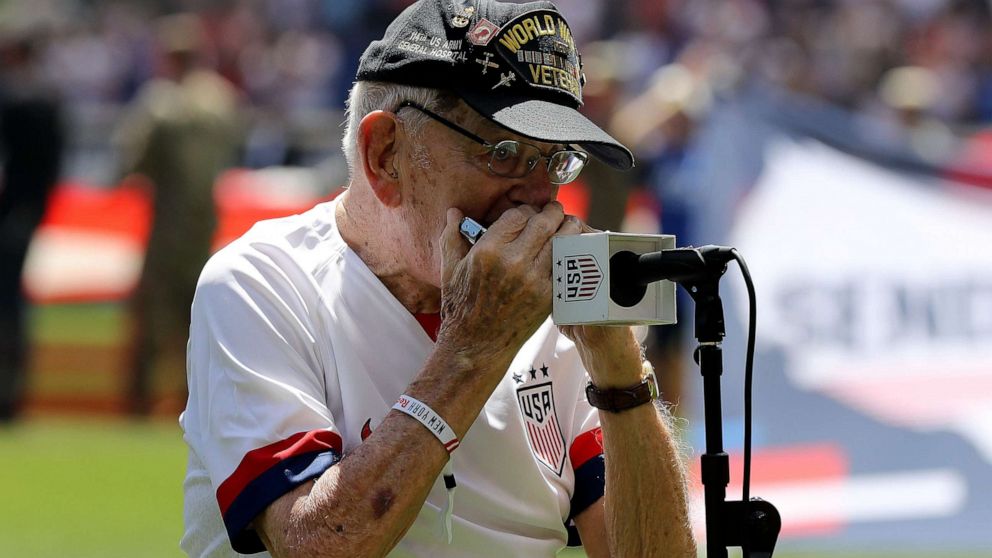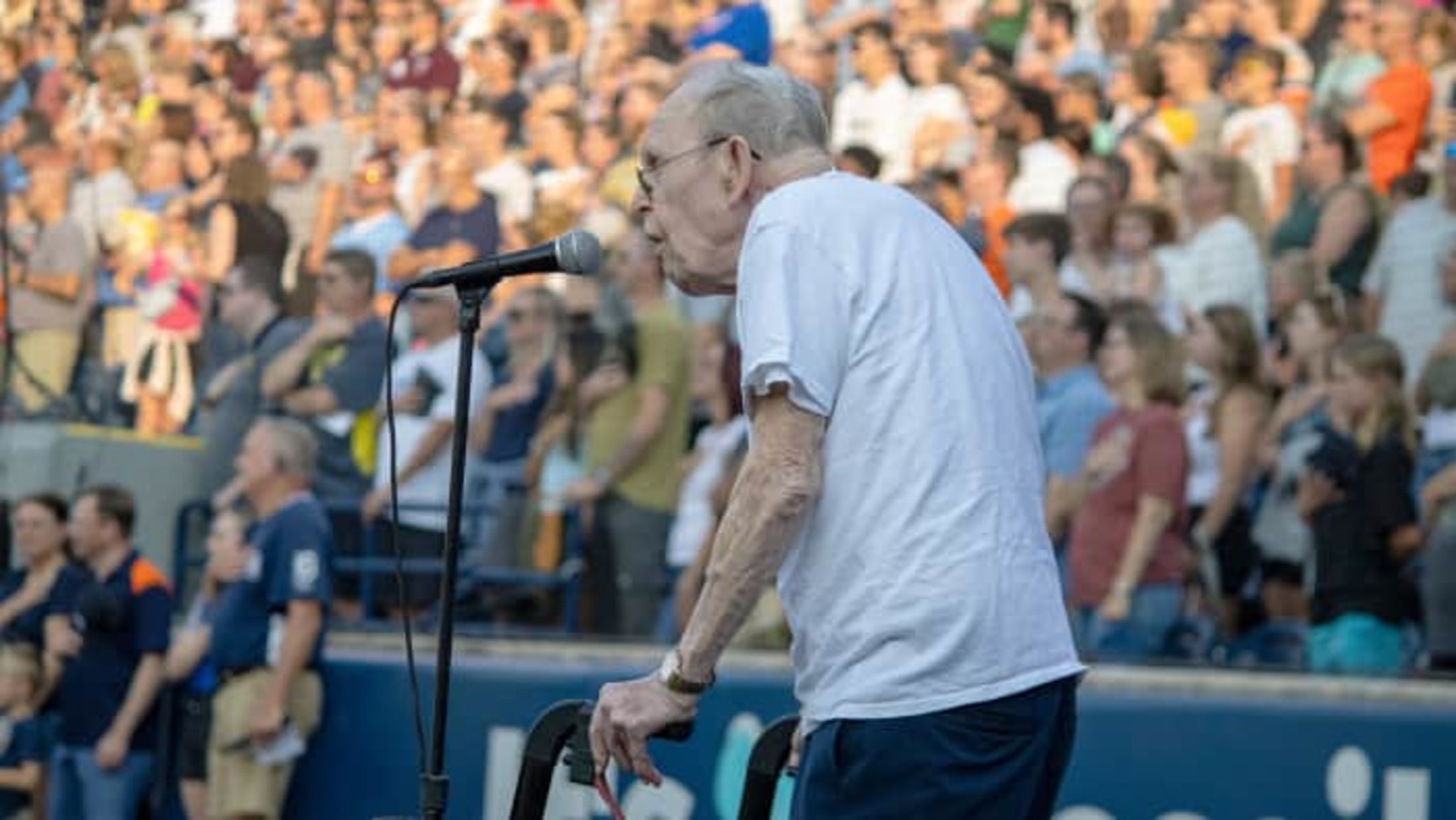
On a bright summer day at a baseball game in Grand Rapids, Michigan, the atmosphere was electric with anticipation—not just for the first pitch, but for something far more meaningful. Before the players took the field, all eyes turned to center field, where 96-year-old World War II veteran John Pylman stood poised and ready to sing the United States National Anthem.
What followed was a moment of unity, patriotism, and heartfelt emotion that resonated not only with the crowd in the stadium but with people across the country once the video of the performance began to circulate online.
A Tribute Rooted in Honor and History
John Pylman, a proud veteran of World War II, is part of what is often called “The Greatest Generation.” According to the U.S. Department of Veterans Affairs, there are fewer than 120,000 WWII veterans still living as of 2025, making each appearance and public tribute by these individuals especially significant.¹
Pylman, dressed in a clean, pressed shirt and slacks, approached the microphone with dignity. Removing his cap—a traditional gesture of respect—he stood tall despite his age and decades removed from active service.
His presence alone was a reminder of the resilience and sacrifice of those who served during one of the most pivotal conflicts in modern history.

A Voice That United Generations
As Pylman began to sing “The Star-Spangled Banner,” his voice, strong and clear, echoed through the stadium. It was a sound filled not only with musicality but with history—each note carrying the weight of experience, service, and dedication to country.
The performance brought together attendees from all walks of life. Families with children, veterans in the crowd, seniors, students, and baseball fans collectively paused to reflect. Hands went over hearts, and many sang along in solidarity. Even those who didn’t sing stood still, heads bowed in respect.
The emotional impact was evident. According to psychology experts at Harvard University, shared rituals like singing the national anthem at public events can promote social bonding and a sense of national identity.² This performance became one such ritual—strengthening the communal spirit of everyone present.

An Anthem for More Than Just a Game
The National Anthem, written by Francis Scott Key during the War of 1812, has long served as a symbol of American perseverance. Though typically performed at sports events as a prelude to the action, moments like Pylman’s rendition give it renewed meaning.
Baseball, often referred to as America’s pastime, has a rich tradition of honoring service members. Organizations like Major League Baseball (MLB) partner with groups such as the Wounded Warrior Project and Veterans of Foreign Wars to spotlight stories of courage and sacrifice.³
Pylman’s performance was a continuation of this tradition—linking America’s love for the sport with its reverence for those who fought for its freedom.

The Crowd’s Response: A Standing Ovation and Shared Emotion
As the final line—”O’er the land of the free and the home of the brave”—rang out across the field, the audience erupted in applause. The energy shifted from silence to standing ovation.
Many in the crowd could be seen wiping away tears. For them, Pylman’s voice wasn’t just a musical performance; it was a reminder of unity, dignity, and enduring patriotism.
Players stood respectfully, caps in hand and hands over hearts, visibly moved. The moment transcended the game.
In a closing gesture, Pylman raised his arm in a salute—an act that spoke volumes. It was a final nod to service, a thank-you to the audience, and a dignified close to a powerful ceremony.

Why These Moments Matter
In a time where national conversations often focus on division, public displays of shared respect like this can provide a necessary reminder of common values.
Events that spotlight veterans, especially those from the Second World War, allow newer generations to better understand and appreciate the hardships endured in the past. Educational institutions and veteran organizations such as the National WWII Museum work to keep these stories alive and accessible for young Americans.⁴
Singing the National Anthem before games is not merely a formality—it is a moment of connection to history and shared identity.
Honoring Veterans Through Music and Memory
Music has long played a role in military tradition. According to the Library of Congress, songs like the National Anthem serve as unifying tools during military ceremonies, civic events, and public gatherings.⁵
For veterans like John Pylman, the act of singing the anthem is more than symbolic—it’s an embodiment of the values they fought for: freedom, unity, and resilience.
These gestures, no matter how simple, allow the public to honor their legacy. They also educate the younger generation on the importance of remembrance and gratitude.

A Ripple Effect Online
Shortly after the performance, a video of the event was shared online by local news outlets and community members. It quickly gained traction, with viewers expressing admiration and gratitude in comments and shares.
“His voice brought tears to my eyes,” one commenter wrote. “It reminded me of my grandfather, who also served in WWII.”
While the reach of the performance extended beyond the stadium, its core message remained the same: honoring those who served and acknowledging the power of unity.
Final Thoughts
John Pylman’s performance was not just a pre-game tradition; it was a moment of reflection and unity that connected thousands of people, both in person and online.
Through his voice, attendees were reminded of the strength and sacrifice that shaped the nation. They also saw the beauty of intergenerational respect—where a nearly century-old veteran could command the admiration of a modern audience.
In today’s fast-moving world, these moments ground us. They remind us of where we’ve come from and the values that still matter—respect, unity, and patriotism.
As applause echoed through the Michigan stadium and online hearts lit up with appreciation, one thing was clear: the anthem, in the voice of a veteran, continues to inspire.



